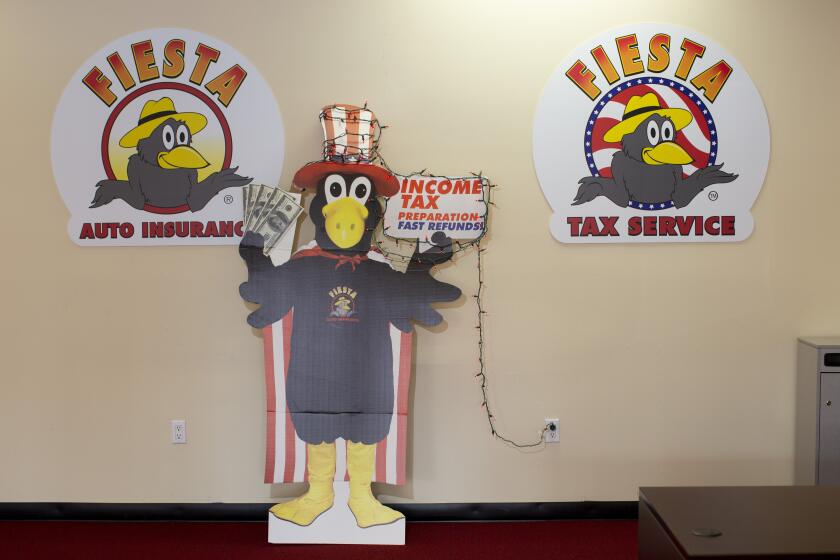L.A.’s best logo belongs to Western Truck Exchange. Prove us wrong
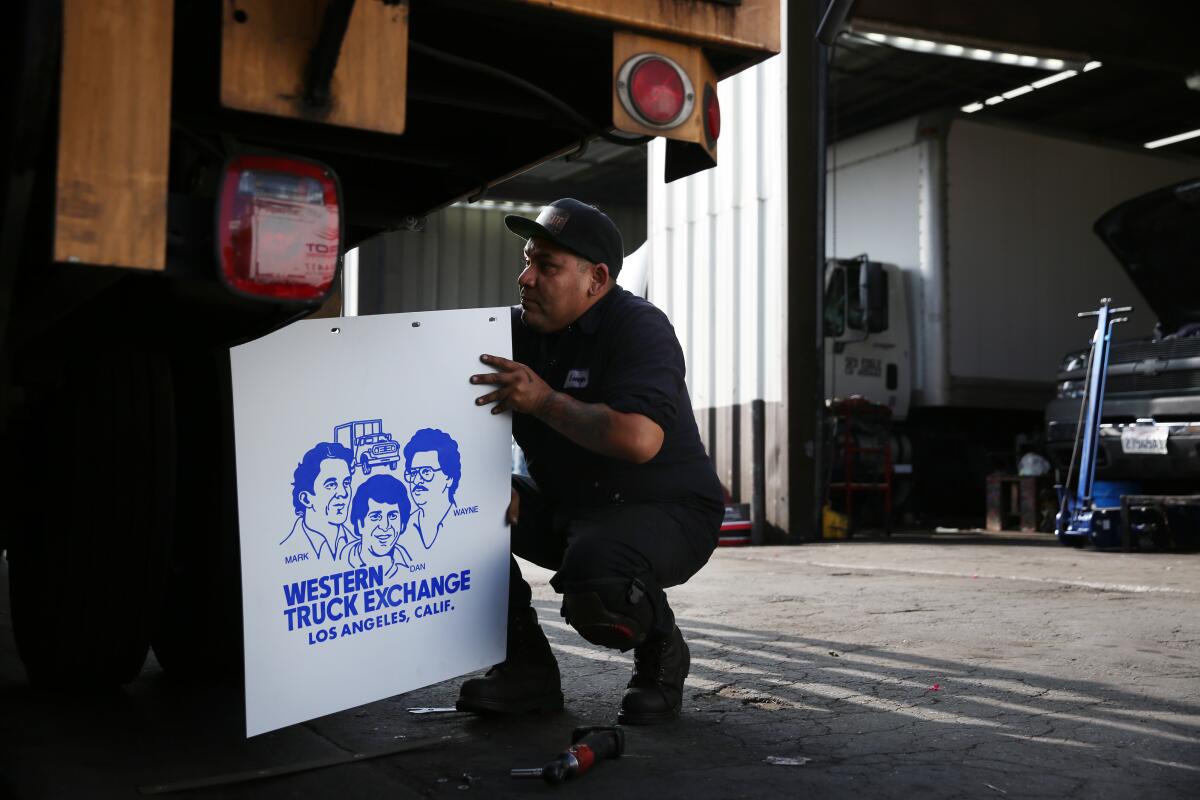
It’s the logo Southern Californians can’t escape: cartoon caricatures of three guys named Mark, Dan and Wayne and the words “Western Truck Exchange,” placed on thousands of truck mudflaps in a city so dry that mudflaps are essentially unnecessary.
Who are these people, and who dreamed up the cheesy/terrible/classic/wonderful blue logo?
Since 1982, this has been the insignia of a four-generation family business that has been around, in one form or another, since 1922.
Mark, Dan and Wayne are the Holtzman brothers, and Western Truck Exchange is a well-known name in commercial and government circles for truck purchase and repair.
The company sells new and used trucks, sometimes modified to customer specifications, and takes care of licensing and financing. It services vehicles as varied as fire engines, school buses and armored money trucks.
The logo explains none of that, but it’s what draws people in, said Dan Holtzman, 67, president and general manager of the business.
Felix. Little Man. And a foot with mixed emotions.
Dan jokes that they will bolt mudflaps “on anybody who stops long enough for us to put them on.”
“We are probably putting them on 300 trucks a year. Do the math. It means there are a lot of Mark, Dan and Wayne mudflaps rolling around,” he said.
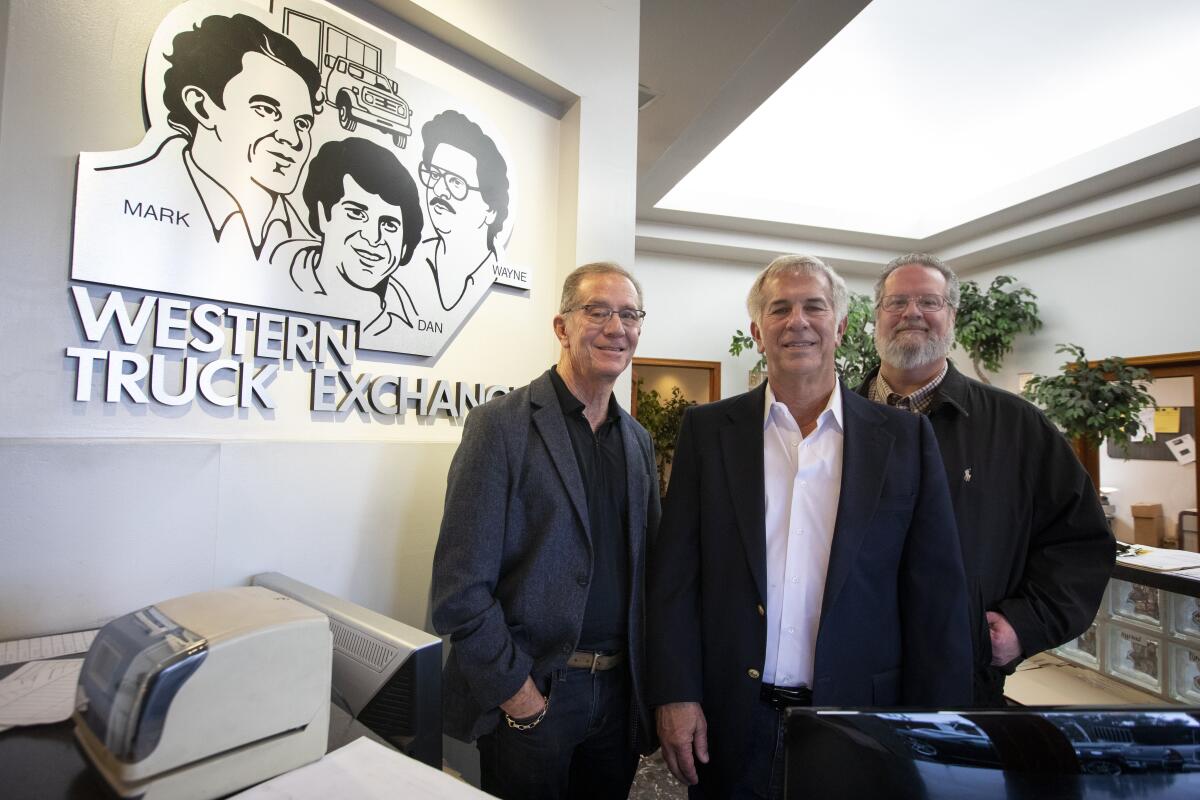
In an era of media bombardment, logos are an important way for businesses to declare what they’re about. Consumers get so attached to certain logos that even a small change can fuel immediate internet outrage, as Starbucks Corp., the Gap retail chain and even the Library of Congress can attest.
Lots of Southern California companies have famous logos, including Walt Disney Co. with its castle and shooting star overlaid with a script typeface. But in a town often quick to erase its own history, true devotion generally is reserved for the increasingly rare sort of design that’s heavy on the human element, epitomized by the Western Truck Exchange logo.
Consider this summer’s controversy stirred up by the removal of Silver Lake’s Happy Foot Sad Foot sign after the relocation of the podiatry clinic that owned it. The rotating sign, which had stood at Sunset Boulevard and Benton Way since roughly 1985, was a before-and-after ad for Sunset Foot Clinic, with one side featuring a sad foot cartoon character leaning on a crutch followed by a spry, smiling foot on the other.
Western Truck Exchange’s logo also has achieved cult status — and frequent appropriation. The brothers say they don’t know where the design will show up next.
T-shirts bearing the logo were found on clothing racks at Bloomingdale’s and Urban Outfitters in the early 2000s.
The shirts found their way into a 2006 teen fantasy movie called “Aquamarine,” starring Emma Roberts and Joanna Levesque. Dan, who is known as “Pops” to his grandchildren, was watching the film with them when the kids got very excited.
“There are teenagers walking around with our logo on their T-shirts. We don’t know where they came from,” Dan said. “One of my grandkids sees it and says, ‘Look! Pops is on TV!’ ”
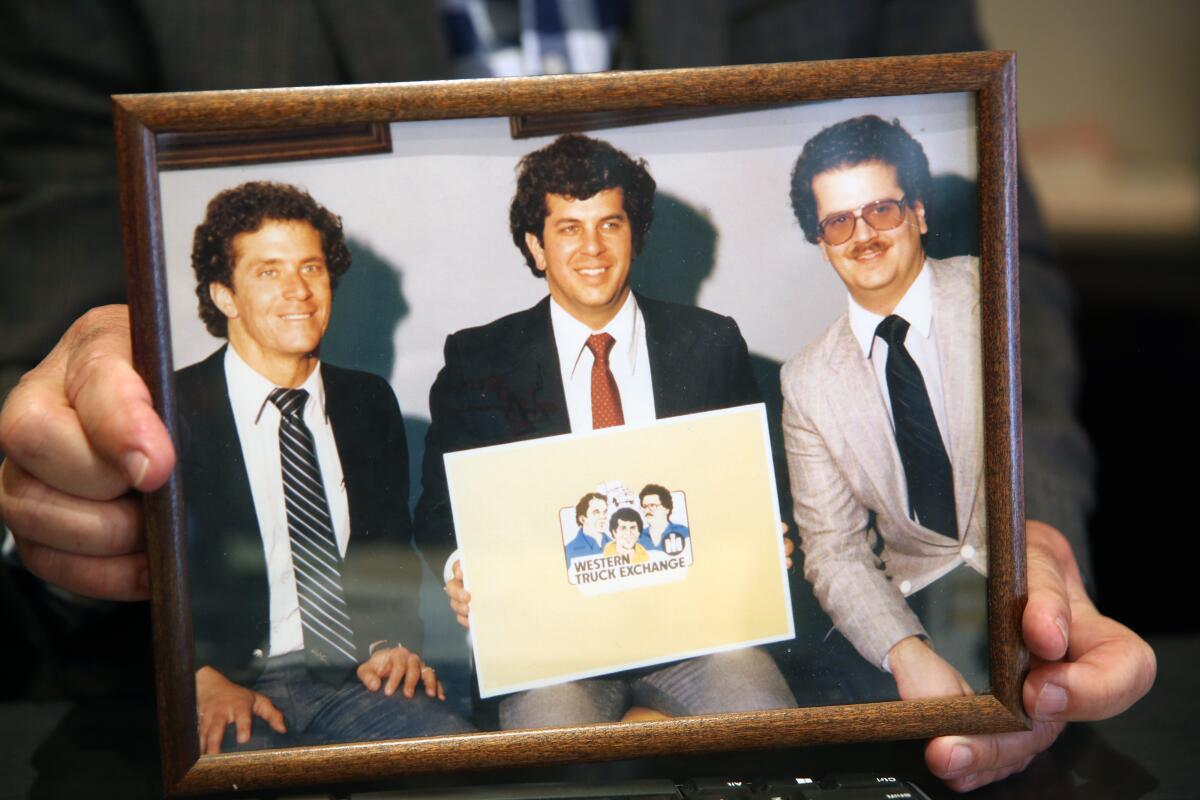
It’s happening still.
Western Truck Exchange merchandise can be found at various online outlets, but only some of it is officially licensed by the company.
On the Redbubble website, items including smartphone cases and T-shirts with the logo are sold by artist Keri Ann Martin, who goes by the name of kamiospeedwagon. Martin said she spent hours poring over photographs of mudflaps to accurately reproduce the logo.
“Of all the vintage logos I’ve re-created, this one took the most amount of work,” she said. “It was clearly worth it, though, as it sells more than any of my other works. So I’m super stoked I was able to fill that gap for everyone else who appreciates the greatness of this vintage design.”
The company doesn’t bother suing.
“If someone wants to advertise and enhance my brand for free, why am I going to give them a hard time about it?” Dan said.
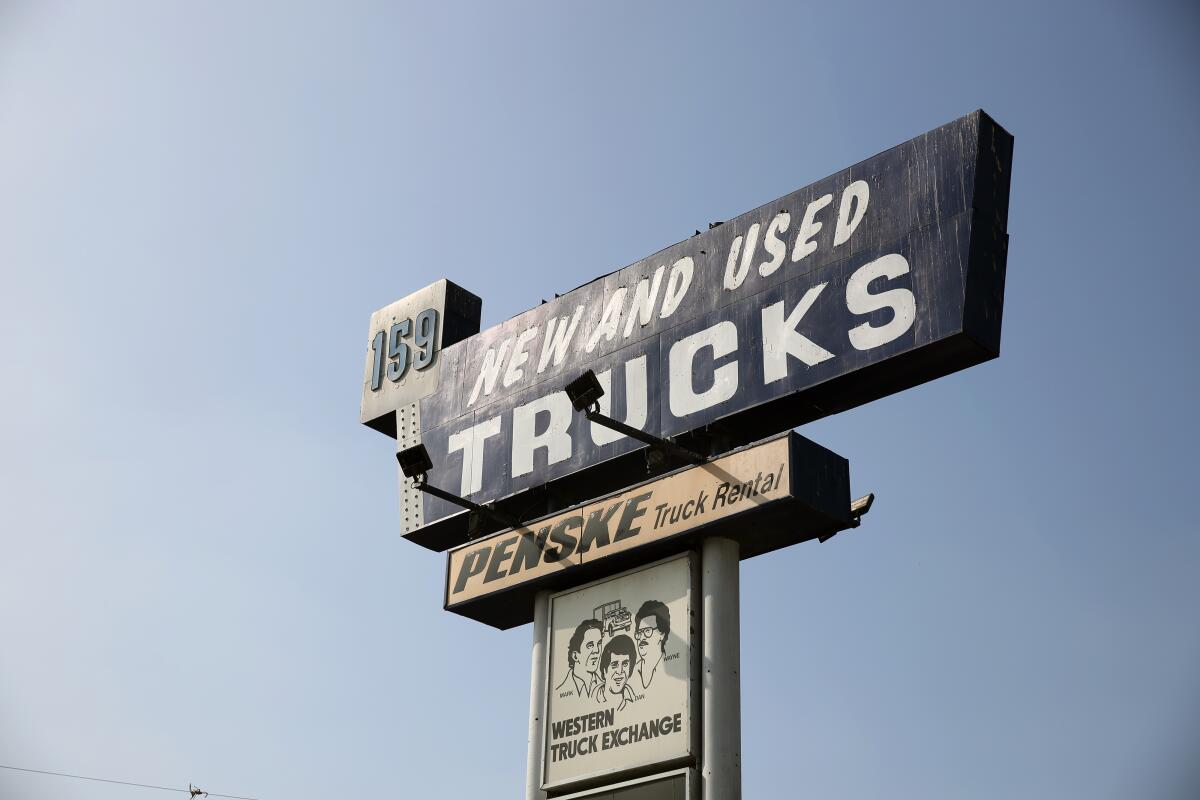
The business was launched in 1922 by Edward Brown as the Western Motor Exchange. It started out as a used-car dealership, but the city was changing rapidly.
In the 1920s, Los Angeles surpassed San Francisco as the busiest seaport on the West Coast. More and more trucks were needed to haul cargo. In 1950, the dealership switched from used cars to used trucks.
“They wanted to differentiate themselves,” Dan said, “so the business evolved into selling trucks. Then they called it Western Truck Exchange.”
Son-in-law Abe Holtzman, grandfather to the three brothers, joined the business. The trio’s dad, Seymour, and an uncle, Aaron Fox, signed on in the 1940s.
Dan, in the 1970s, was about to purchase his own dealership when he was persuaded to join the family firm. By the time he was 25, an illness in the family had led him to take over the operation.
Brother Wayne, now 63, came on as the parts manager. Mark, now 65, joined to handle truck sales.
The three brothers settled quickly into their roles, Wayne said, falling back on their experiences when they had a musical band.
“It was then totally natural for me to transition from band member to Western Truck Exchange employee. Although the work was different, our working relationship did not change,” he said. “The typical family member animosity did not exist.”
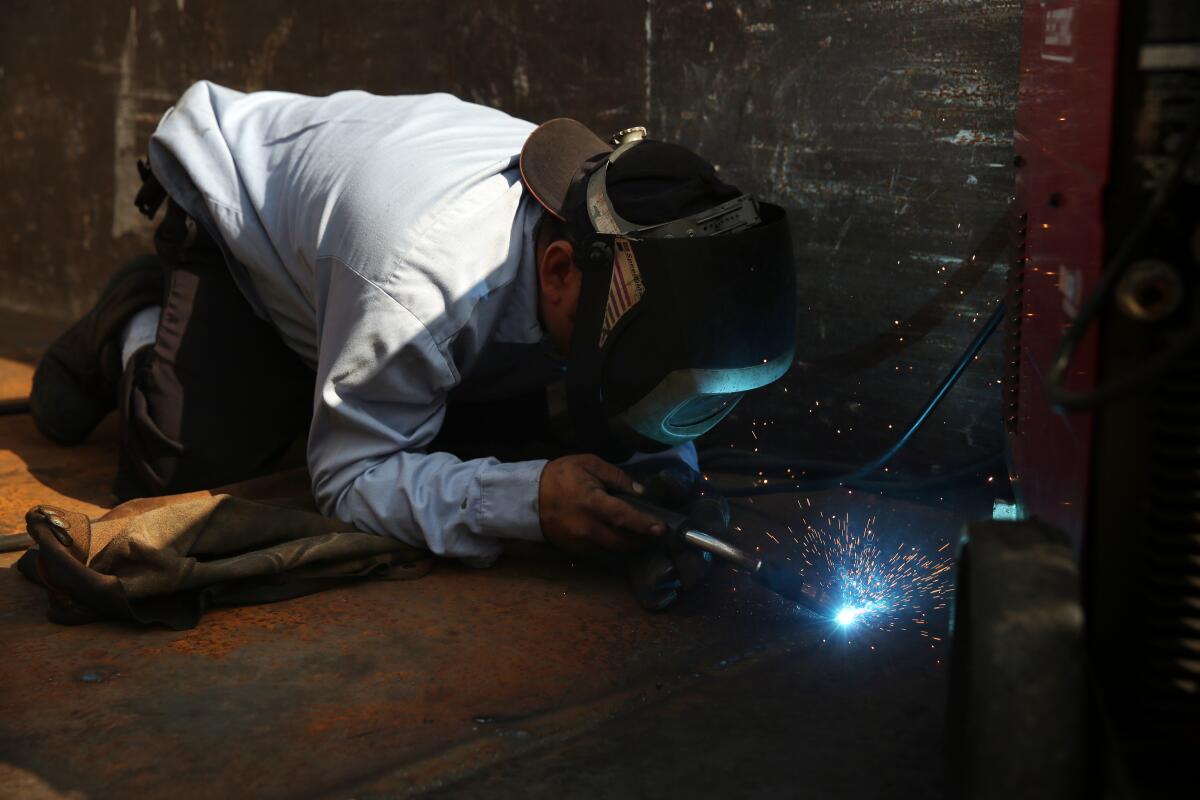
In 1982, facing stiff competition from more than a dozen truck dealerships, the brothers came up with the idea of a logo to help separate them from their rivals. The Holtzmans wanted something to appeal to a growing Latino marketplace, which they were told is brand loyal and family oriented.
“Well, we were three brothers, and we are a family, so we hired a guy to take our picture, and he turned it into a caricature,” Dan said. “Then we just started buying mudflaps. When we asked if we could install them, most people said, ‘Sure, put it on, we don’t care.’ ”
Wayne said the logo “immediately set us apart from the competition and helped establish us as a recognizable neighborhood dealership. Since that time, we have been able to adapt our family-business approach to compete with the large mega dealerships that surround us.”
Mark eventually left to run his own aerial photography business. Wayne remains as managing director of the parts operations center.
A fourth brother, Bob, 61, started an insurance outfit called Western Truck Insurance. The brothers refer business to each other.
On a typical day, vehicles await repair and maintenance at a boxy structure that Dan had built in 1979 on West Manchester Avenue, adjacent to the Harbor Freeway. A few blocks down the street, new trucks are on display at a spot built in the 1940s by Abe.
Customers say their businesses depend on the Holtzmans’ company to keep their trucks running smoothly.
“Anytime we need a new truck, we know who to call,” said Howard Wizenberg, president of Westside Door & Moulding, which sells doors, windows and other building supplies. Western Truck Exchange is “a very honest and reliable source for our transportation needs.”
Bumps in the economy aren’t a big deal to Western Truck Exchange. When there is a slowdown and people aren’t buying new trucks, they still need to maintain their old rigs. When the economy is strong, sales become the more important part of the business.
“Our company is based on three words: Trucks must run,” Dan said. “Technology is changing, but things still have to move from one place to another.”
There’s another generation in the business now. Dan’s son Andrew, who’s in charge of fleet sales, is 39 and being groomed to help run the business one day.
“I always thought trucks were fairly wonderful, especially fire-rescue trucks and dump trucks,” Andrew said. “Now that I get to sell them to the local municipalities and to the state of California, I really get a sense of fulfillment knowing that these vehicles are used to rescue people and to otherwise help the community.”
With at least one new generation in the business, there might be some discussion about changing the logo to add new names. But Dan says there’s only one way anyone new gets added to the logo.
“The front side of the mudflap is full,” Dan laughed. “Anyone new has to go on the back side, the mud side.”
More to Read
Inside the business of entertainment
The Wide Shot brings you news, analysis and insights on everything from streaming wars to production — and what it all means for the future.
You may occasionally receive promotional content from the Los Angeles Times.
